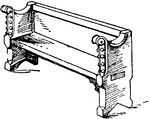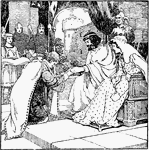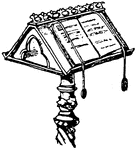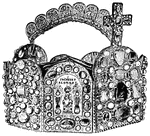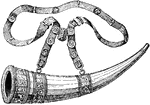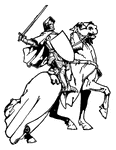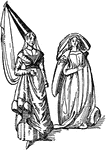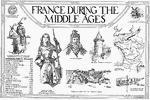
Écu
"The shield carried by a mounted man-at-arms in the middle ages; especially, the triangular shield of…

Sirs John de Creke and John of Eltham Wearing Armor
Sirs John de Creke and John of Eltham wearing armor during the fourteenth century. The illustration…
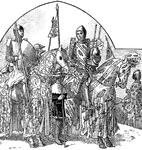
Knights and Noblemen on Horses Wearing Armor
The illustration shows two knights riding on horses. The knights and noblemen wore surcoats to hide…
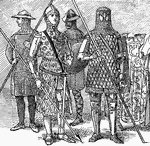
Men at Arms Wearing Armor
An illustration of men at arms wearing iron body armor. The illustration shows armors varied by wealth…

Francisca, Throwing Axe
"A battle-ax used by the Franks, of which the typical form is a head long in proportion to its width,…
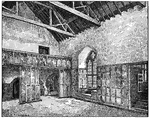
Gothic Architecture Banquet Hall
"The Banqueting Hall at Haddon is a good type of the baronial halls in this century. The minstrels'…
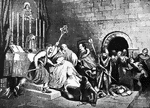
Death of Becket
"Death of Becket. During the early years of the reign Thomas A. Becket, as the king's chancellor, had…

Medieval Bedstead
The Medieval bedstead of the 13th century was richly decorated with turned posts and carved sides. The…

Medieval Bedstead
The Medieval bedstead of the 12th century was richly decorated with turned posts and carved sides. The…

Medieval Bench
The Medieval bench was also called a Double-bench with a back in the middle, this back was moveable.…

Middle Ages Bench
The Middle Ages Bench was used not only as a seat but as a table as well called a "work-bench". It was…
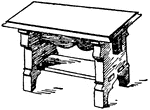
Middle Ages Bench
The Middle Ages Bench was used not only as a seat but as a table as well called a "work-bench". It was…

Fourteenth Century Illumination Ornaments Border
A border ornamentation used in illuminated manuscripts during the fourteenth century.
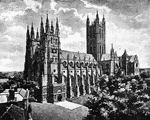
Canterbury Cathedral
"Canterbury Cathedral, which was a key place during the contest with King John. In the quarrel with…

Gothic Architecture Arch Moulding Sunk Chamfer
A section of an arch with sunk chamfer commonly found in Gothic architecture during the fourteenth century.…

Charlemagne
"Statue of Charlemagne, in Paris. At Pepin's death in 768 the kingdom of the Franks included the greater…

Medieval Chest
This Medieval chest is from England. It was a prismatic box without feet, with delicate iron mounts…

Gothic Architecture City Gate
An illustration of a city gate in York during the fourteenth century illustrating Gothic architecture.…

Gothic Architecture Alfriston Clergy House
A clergy house in Alfriston, England illustrating typical Gothic architecture during the fourteenth…

Gothic Architecture Ornaments Column Base
The base of the column illustrating the Gothic ornamentation during the fourteenth century. The bottom…

Gothic Architecture Column
An illustration of Gothic architectural decoration of the column. The column illustrated shows how the…
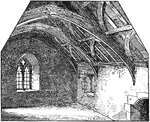
Interior Somersetshire Fisherman's Cottage
The interior view of the Fisherman's Cottage in Somersetshire. The interior of the cottage have a window…
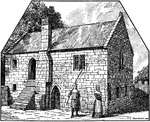
Somersetshire Fisherman's Cottage
An outside view of a fisherman's cottage in Somersetshire illustrating common architectural features…
Gothic Architecture Decoration
A Gothic architectural ornamentation commonly found during the fourteenth century. The crocket was a…
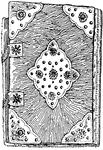
Domesday Book
The Domesday or Book of Winchester was a survey or census of England completed in 1086 for William the…
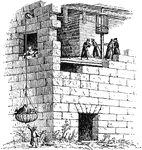
Early Elevator
This medieval elevator shows the use of two simple machines: wheel and axle on the right, and a pulley…

Encaustic Tile
"Encaustic tile, a tile for pavement- and wall-decoration, in which the pattern is inlaid or incrusted…
Fauchard of the 15th Century
"Fauchard of the 15th century. A weapon of the middle ages consisting of a scythe-shaped blade with…

Gothic Architecture Finial
An architectural decoration of the finial commonly found in Gothic architecture. The finial was used…

Frate della Misericordia
"A Frate della Misericordia. MISERICORDIA, the name of a society (of laymen) in Florence, founded in…

Godfrey de Bouillon Tomb
"Tomb of Godfrey de Bouillon. During the Crusades, the Kingdom of Jerusalem in 1099. The conquered lands…
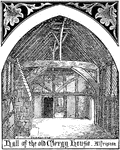
Gothic Architecture Alfriston Clergy House Hall
An illustration of the hall in Alfriston Clergy House. The hall illustrates typical architectural support…

Northampton St. John's Hospital
The middle window is the tracery found on the St. John's Hospital, Northampton. The two faces on the…
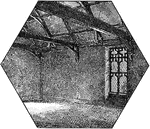
Gothic Rectory in Market Deeping House
The interior view of the rectory in Market Deeping during the fourteenth century. The empty room contains…

Merchant's Parlour Salisbury House
An interior view of a merchant's parlour in Salisbury during the fourteenth century. The interior have…
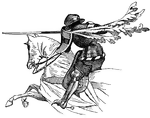
A Knight on Horseback, Wearing a Woman's Sleeve as a Favor
Illustration of a knight, riding a horse at full gallop, carrying a javelin and wearing full armor.…
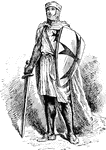
Knight Templar
"A Knight Templar. During the Crusades, there were military and religious orders. Between the first…
Bedouin Lance Heads
"The Lance is a weapon consisting of a long shaft with a sharp point, much used, particularly before…
Bedouin Lance Heads
"The Lance is a weapon consisting of a long shaft with a sharp point, much used, particularly before…

Medieval Lectern
This medieval lectern is from Venice, Italy. Often with a design of an eagle, these desks were of rich…
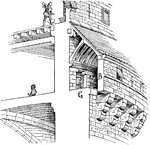
Machicolation
A machicolation is a floor opening between the supporting corbels of a battlement, through which stones…
